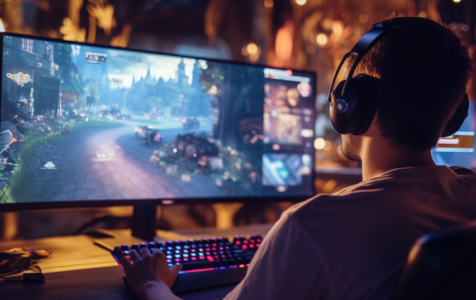This guide will help you make your video games run smoother on your Windows computer by increasing your “Frames Per Second” or FPS. It begins by establishing why higher FPS can offer a more fluid gaming experience. It then moves on to outline common factors that might be reducing your FPS, such as outdated hardware or software.
The core of the article provides practical steps for increasing FPS:
- Keep the software that controls your computer’s graphics up to date.
- Change the game’s own settings, such as how clear the picture is (resolution) and render distance (how far you can see in the game ).
- Use special features on your Windows computer, like “Game Mode,” to make games run better.
- Close programs you’re not using to free up your computer’s power for gaming.
- Consider evaluating and potentially upgrading hardware components like SSDs (faster storage drives) and RAM (temporary memory).
- If you know what you’re doing, you can overclock your CPU (the main computer processor) and GPU (graphics processor) to make them run faster, but be cautious as this can make your system unstable or cause it to overheat.
Always keep track of your FPS as a way to measure the impact of your adjustments.
Why FPS Matters
With a higher FPS your games will look smoother and react more quickly to your actions, making it more fun to play. While a range of 30 to 60 FPS is generally acceptable, those looking to compete often aim for even higher rates, such as 144 to 360 FPS.
Expert Tip: For smoother PC performance, consider using a PC optimization tool. It handles junk files, incorrect settings, and harmful apps. Make sure it's right for your system, and always check the EULA and Privacy Policy.
Special offer. About Outbyte, uninstall instructions, EULA, Privacy Policy.
Factors Contributing to Low FPS
A variety of elements can hamper your FPS:
- Outdated or underpowered graphics card
- Obsolete CPU
- Insufficient RAM
- Outdated graphics drivers
Optimal FPS and Monitor Refresh Rate
To get the most out of your setup, it’s advisable to match your FPS with your monitor’s refresh rate. A system capable of consistently delivering an FPS equal to the monitor’s refresh rate will offer a smoother, more immersive experience. However, achieving the optimal FPS is not solely reliant on your monitor; your computer’s GPU, CPU, and RAM are all pivotal factors in frame rate performance.
Understanding the relationship between FPS and refresh rate is crucial for optimizing your gaming setup. Whether you are upgrading your monitor or tweaking your existing hardware, this knowledge will help you make informed choices for a flawless gaming experience.
How to Boost FPS: Quick Tips
Update Graphics Drivers
Keep your graphics drivers updated to gain performance benefits, including game-specific enhancements. Check for updates regularly through your Nvidia, AMD, or Intel graphics control panel.
Fine-Tune In-Game Settings
In the quest for a smoother gaming experience, understanding and tweaking game settings can make a world of difference in FPS (Frames Per Second). Here’s a rundown of some essential settings to consider:
Vsync: The Fix for Screen Tearing
Vsync is a setting that makes sure the game’s visuals match up well with your computer screen, stopping any ‘jumpiness’ in the picture. This prevents ‘screen tearing,’ where an image appears disjointed due to the frame and refresh rates being out of sync. However, keep in mind that while Vsync can improve visual quality, it may sometimes reduce your FPS slightly.
Anti-aliasing: Aesthetics Meets Performance
Anti-aliasing is a feature that makes the edges of things in the game look smoother. It can be demanding on your system, thus potentially lowering your FPS.
Draw Distance: How Far Can You See?
Draw distance is a setting that controls how far away you can see things in the game. Lowering this setting reduces the objects rendered by the game, thereby improving FPS, as your system doesn’t have to render as many objects in the distance. It can also limit your field of view.
Graphics Settings: The Balancing Act
Certain graphics settings such as motion blur, shadow quality, texture details, and lighting effects can consume considerable system resources. Disabling motion blur and reducing the intensity of shadows and lighting effects can improve FPS without drastically compromising visual appeal.
Use Windows Built-In Optimizations
Available in Windows 10 and 11, this feature limits background processes to improve gaming performance.
Manage Background Applications
Closing unnecessary applications can free up system resources, leading to a smoother gaming experience.
Check Your Hardware
- Use an SSD, a faster type of storage, instead of an HDD, to make your games and computer start up faster.
- RAM: Make sure your RAM operates at its intended MHz to enhance both gaming and system performance.
- CPU and GPU Overclocking: If you’re considering this, make sure to proceed cautiously and ensure your system has adequate cooling.
Consider Hardware Upgrades
Sometimes, a hardware upgrade is the most effective way to boost gaming performance. Ensure your system meets the minimum requirements for your intended games before making any upgrades.
Measuring Your Gains
To evaluate the effectiveness of your optimizations, keep an eye on your FPS while gaming.
Conclusion
To sum up, this guide gives you a comprehensive toolkit for significantly improving your gaming experience on a Windows computer. Here are the key takeaways:
- Keep an eye on your FPS as a performance metric to judge the effectiveness of your adjustments.
- Update your graphics drivers regularly for optimized gameplay.
- Fine-tune your in-game settings to balance visual appeal with performance.
- Utilize built-in Windows features and manage background applications to allocate more system resources to your game.
- Consider hardware upgrades like SSDs and RAM to meet or exceed game requirements.
- Overclocking is an option but proceed with caution, keeping system stability and heat management in mind.
Armed with these strategies, you’re now ready to tailor your setup for a smoother, more responsive gaming experience. Happy gaming!
